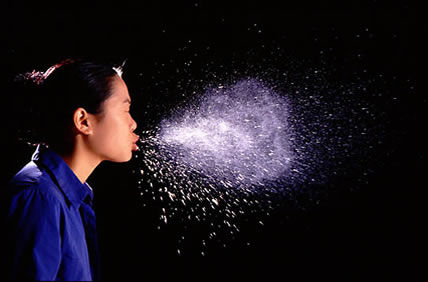The CDC is finally admitting this fact.
The CDC put out a new poster stating:
Droplet spread happens when germs traveling inside droplets that are coughed or sneezed from a sick person enter the eyes, nose, or mouth of another person. Droplets travel short distances, less than 3 feet (1 meter) from one person to another.Meryl Nass, M.D. - a board-certified internist and a biological warfare epidemiologist and expert in anthrax - comments:
A person might also get infected by touching a surface or object that has germs on it and then touching their mouth or nose.
***
Clean and disinfect commonly touched surfaces like doorknobs, faucet handles, and toys, since the Ebola virus may live on surfaces for up to several hours.
CDC says it doesn't travel farther than 3 feet. Well, at least CDC is starting to move the narrative. Maybe tomorrow it will be 5 feet. Then 10. Maybe next month they will tell us why all the victims' possessions are being incinerated and apartments fumigated.And see this:
Just remember: historically, Ebola spread fast in healthcare facilities.
Comment:
We also demonstrated aerosol transmission of Ebola virus at lower temperature and humidity than that normally present in sub-Saharan Africa. Ebola virus sensitivity to the high temperatures and humidity in the thatched, mud, and wattel huts shared by infected family members in southern Sudan and northern Zaire may have been a factor limiting aerosol transmission of Ebola virus in the African epidemics. Both elevated temperature and relative humidity (RH) have been shown to reduce the aerosol stability of viruses (Songer 1967). Our experiments were conducted at 240C [i.e. 75 degrees Fahrenheit] and < 40% RH, conditions which are known to favour the aerosol stability of at least two other African haemorrhagic fever viruses, Rift Valley fever and Lassa (Stephenson et a/. 1984; Anderson et a/. 1991). If the same holds true for filoviruses [Ebola is a type of filovirus], aerosol transmission is a greater threat in modern hospital or laboratory settings than it is in the natural climatic ranges of viruses.
Dr. Nass previously argued that the CDC has been lying about aerosol transmission of Ebola, as its own 2009 publication admitted that Ebola:
pose[s] a high individual risk of aerosol-transmitted laboratory infections and life-threatening disease that is frequently fatal, for which there are no vaccines or treatments...




Reader Comments
Quote: "Droplets travel short distances, less than 3 feet (1 meter) from one person to another".
Strange that the droplets infected with ebola remain unaffected by air currents. Did the CDC give an explanation as to how the virus alters the laws of physics?
It turns out smaller droplets travel further:
"Droplets that are 100 micrometers in diameter were found to travel five times farther than past estimates, while droplets 10 micrometers in diameter were found to travel 200 times farther. In addition, the team found that droplets less that 50 micrometers in size are often able to stay airborne long enough to enter ceiling ventilation units."
From: "[Link]
What's the next change...
Your infectious from day one, with or without symptoms.
Or Ebola is a lot more infectious than we thought.
Or will it be... We need to increase the quarantine from 21 days to 60 days.
This outbreak is beginning to sound more like the mutant offspring of Flu and Ebola, with all the bad bits of both.